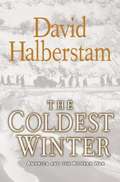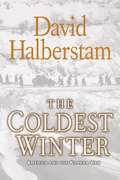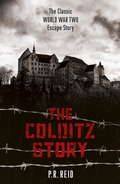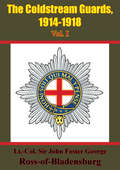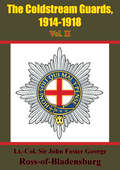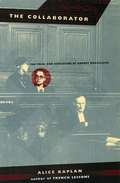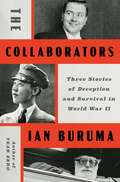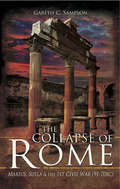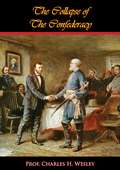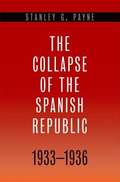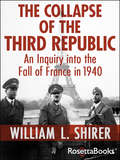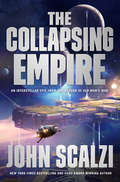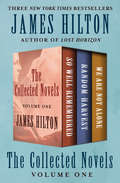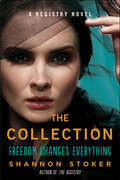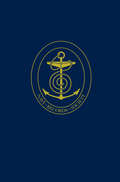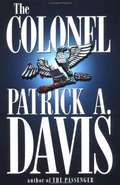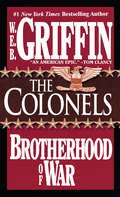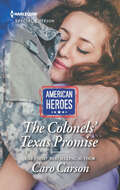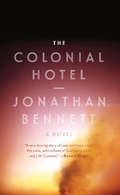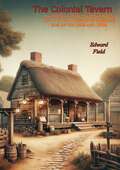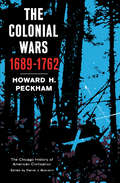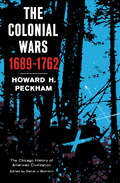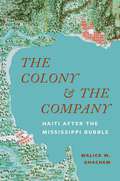- Table View
- List View
The Coldest Winter: America and the Korean War
by David HalberstamA masterful narrative of the political decisions and missteps on both sides with nuanced portraits of all the major figures of the war
The Coldest Winter: America and the Korean War
by David Halberstam"In a grand gesture of reclamation and remembrance, Mr. Halberstam has brought the war back home."--The New York TimesDavid Halberstam's magisterial and thrilling The Best and the Brightest was the defining book about the Vietnam conflict. More than three decades later, Halberstam used his unrivaled research and formidable journalistic skills to shed light on another pivotal moment in our history: the Korean War. Halberstam considered The Coldest Winter his most accomplished work, the culmination of forty-five years of writing about America's postwar foreign policy.Halberstam gives us a masterful narrative of the political decisions and miscalculations on both sides. He charts the disastrous path that led to the massive entry of Chinese forces near the Yalu River and that caught Douglas MacArthur and his soldiers by surprise. He provides astonishingly vivid and nuanced portraits of all the major figures-Eisenhower, Truman, Acheson, Kim, and Mao, and Generals MacArthur, Almond, and Ridgway. At the same time, Halberstam provides us with his trademark highly evocative narrative journalism, chronicling the crucial battles with reportage of the highest order. As ever, Halberstam was concerned with the extraordinary courage and resolve of people asked to bear an extraordinary burden.The Coldest Winter is contemporary history in its most literary and luminescent form, providing crucial perspective on every war America has been involved in since. It is a book that Halberstam first decided to write more than thirty years ago and that took him nearly ten years to complete. It stands as a lasting testament to one of the greatest journalists and historians of our time, and to the fighting men whose heroism it chronicles.
The Colditz Story
by Major P ReidColditz was the last stop for prisoners of war during WWII. Those who persisted in escaping from other camps were sent to the impregnable fortress of Colditz Castle, situated on a rocky outcrop high above the River Mulde. Once within the walls of the castle, the Germans reasoned, escape was impossible. And yet many prisoners attempted escape and many succeeded Pat Reid was one of those men. Appointed 'Escape Officer' by his fellow inmates, he masterminded many of the attempts. From tunnelling, to hiding in rubbish sacks, disguising themselves as German officers and even leaping from the castle walls, nothing was too dangerous or foolhardy compared to imprisonment by the enemy. Reid's own escape, in 1942, was both one of the most simple and the most daring. First published in 1952, The Colditz Story is a classic escape story in the tradition of The Great Escape and The Wooden Horse.
The Colditz Story
by Major R ReidColditz was the last stop for prisoners of war during WWII. Those who persisted in escaping from other camps were sent to the impregnable fortress of Colditz Castle, situated on a rocky outcrop high above the River Mulde. Once within the walls of the castle, the Germans reasoned, escape was impossible. And yet many prisoners attempted escape and many succeeded Pat Reid was one of those men. Appointed 'Escape Officer' by his fellow inmates, he masterminded many of the attempts. From tunnelling, to hiding in rubbish sacks, disguising themselves as German officers and even leaping from the castle walls, nothing was too dangerous or foolhardy compared to imprisonment by the enemy. Reid's own escape, in 1942, was both one of the most simple and the most daring. First published in 1952, The Colditz Story is a classic escape story in the tradition of The Great Escape and The Wooden Horse.
The Coldstream Guards, 1914-1918 Vol. I [Illustrated Edition] (The Coldstream Guards, 1914-1918 #1)
by Lt. Col. Sir John Foster George Ross-of-BladensburgIncludes 27 maps"History of the four active service battalions in the Great War with details of officers' services during the war.The Coldstream Guards had three battalions in August 1914, all three committed to the BEF: the 1st Battalion was in the 1st (Guards) Brigade, 1st Division; the 2nd and 3rd were both in 4th Guards Brigade, 2nd Division. As soon as war broke out a Reserve battalion (the 4th) was formed which provided drafts of 16,860 all ranks during the course of the war. In July 1915 a further battalion was raised as the Guards Pioneer Battalion for the Guards Division which was then being formed. This battalion was numbered 4th and the reserve battalion became the 5th. In all the Regiment suffered 14,137 casualties of which the dead numbered 180 officers and 3,860 other ranks. Seven VCs were won and 36 Battle Honours awarded. Volume I takes the story to the end of the Somme offensive, volume II begins with the situation at the end of 1916 after the Somme and carries through to the return of the Regiment to London in March 1919 and the Royal Review on the 22nd of that month when the Guards Division marched past their Colonel in Chief, the King.This is a well written history in which the author gives a good and detailed account of the Regiment's actions, often with casualty details following various battles and nominal rolls of officers present for duty. He also comments on the wider issues, some of which had nothing to do with the Coldstream, not only on higher strategy on the Western Front but also on other campaigns such as Gallipoli, Mesopotamia, Palestine and Italy where no Guards battalions served, and it is in discussing these wider issues that he is sometimes frankly critical, allocating blame where he feels it belongs.Print ed.
The Coldstream Guards, 1914-1918 Vol. II [Illustrated Edition] (The Coldstream Guards, 1914-1918 #2)
by Lt. Col. Sir John Foster George Ross-of-BladensburgIncludes 27 maps"History of the four active service battalions in the Great War with details of officers' services during the war.The Coldstream Guards had three battalions in August 1914, all three committed to the BEF: the 1st Battalion was in the 1st (Guards) Brigade, 1st Division; the 2nd and 3rd were both in 4th Guards Brigade, 2nd Division. As soon as war broke out a Reserve battalion (the 4th) was formed which provided drafts of 16,860 all ranks during the course of the war. In July 1915 a further battalion was raised as the Guards Pioneer Battalion for the Guards Division which was then being formed. This battalion was numbered 4th and the reserve battalion became the 5th. In all the Regiment suffered 14,137 casualties of which the dead numbered 180 officers and 3,860 other ranks. Seven VCs were won and 36 Battle Honours awarded. Volume I takes the story to the end of the Somme offensive, volume II begins with the situation at the end of 1916 after the Somme and carries through to the return of the Regiment to London in March 1919 and the Royal Review on the 22nd of that month when the Guards Division marched past their Colonel in Chief, the King.This is a well written history in which the author gives a good and detailed account of the Regiment's actions, often with casualty details following various battles and nominal rolls of officers present for duty. He also comments on the wider issues, some of which had nothing to do with the Coldstream, not only on higher strategy on the Western Front but also on other campaigns such as Gallipoli, Mesopotamia, Palestine and Italy where no Guards battalions served, and it is in discussing these wider issues that he is sometimes frankly critical, allocating blame where he feels it belongs.Print ed.
The Collaborator: The Trial and Execution of Robert Brasillach (Studies In Law And Economics Ser.)
by Alice KaplanOn February 6, 1945, Robert Brasillach was executed for treason by a French firing squad. He was a writer of some distinction—a prolific novelist and a keen literary critic. He was also a dedicated anti-Semite, an acerbic opponent of French democracy, and editor in chief of the fascist weekly Je Suis Partout, in whose pages he regularly printed wartime denunciations of Jews and resistance activists. Was Brasillach in fact guilty of treason? Was he condemned for his denunciations of the resistance, or singled out as a suspected homosexual? Was it right that he was executed when others, who were directly responsible for the murder of thousands, were set free? Kaplan's meticulous reconstruction of Brasillach's life and trial skirts none of these ethical subtleties: a detective story, a cautionary tale, and a meditation on the disturbing workings of justice and memory, The Collaborator will stand as the definitive account of Brasillach's crime and punishment. A National Book Award Finalist A National Book Critics Circle Award Finalist "A well-researched and vivid account."—John Weightman, New York Review of Books "A gripping reconstruction of [Brasillach's] trial."—The New Yorker "Readers of this disturbing book will want to find moral touchstones of their own. They're going to need them. This is one of the few works on Nazism that forces us to experience how complex the situation really was, and answers won't come easily."—Daniel Blue, San Francisco Chronicle Book Review "The Collaborator is one of the best-written, most absorbing pieces of literary history in years."—David A. Bell, New York Times Book Review "Alice Kaplan's clear-headed study of the case of Robert Brasillach in France has a good deal of current-day relevance. . . . Kaplan's fine book . . . shows that the passage of time illuminates different understandings, and she leaves it to us to reflect on which understanding is better."—Richard Bernstein, The New York Times
The Collaborators: Three Stories of Deception and Survival in World War II
by Ian BurumaIan Buruma&’s spellbinding account of three near-mythic figures—a Dutch fixer, a Manchu princess, and Himmler&’s masseur—who may have been con artists and collaborators under Japanese and German rule, or true heroes, or something in between.On the face of it, the three characters in this book seem to have little in common—aside from the fact that each committed wartime acts that led some to see them as national heroes, and others as villains. All three were mythmakers, larger-than-life storytellers, for whom the truth was beside the point. Felix Kersten was a plump Finnish pleasure-seeker who became Heinrich Himmler&’s indispensable personal masseur—Himmler calling him his &“magic Buddha.&” Kersten presented himself after the war as a resistance hero who convinced Himmler to save countless people from mass murder. Kawashima Yoshiko, a gender-fluid Manchu princess, spied for the Japanese secret police in China, and was mythologized by the Japanese as a heroic combination of Mata Hari and Joan of Arc. Friedrich Weinreb was a Hasidic Jew in Holland who took large amounts of money from fellow Jews in an imaginary scheme to save them from deportation, while in fact betraying some of them to the German secret police. Sentenced after the war as a con artist, he was regarded regarded by supporters as the &“Dutch Dreyfus.&”All three figures have been vilified and mythologized, out of a never-ending need, Ian Buruma argues, to see history, and particularly war, and above all World War II, as a neat story of angels and devils. The Collaborators is a fascinating reconstruction of what in fact we can know about these incredible figures and what will always remain out of reach. What emerges is all the more mesmerizing for being painted in chiaroscuro. In times of life-and-death stakes, the truth quickly gets buried under lies and self-deception. Now, when demagogues abroad and at home are assaulting the truth once more, the stories of the collaborators and their lessons are indispensable.
The Collapse of Rome: Marius, Sulla & the 1st Civil War (91-70 BC)
by Gareth C. SampsonThe fall and rise of ancient Rome from more than two decades of internal conflict, as its aristocracy took up arms against each other. By the early first century BC, the Roman Republic had already carved itself a massive empire and was easily the most powerful state in the Mediterranean. Roman armies had marched victoriously over enemies far and wide, but the Roman heartland was soon to feel the tramp of armies on campaign as the Republic was convulsed by civil war and rival warlords vied for supremacy, sounding the first death knell of the Republican system. At the center of the conflict was the rivalry between Marius, victor of the Jugurthine and Northern wars, and his former subordinate, Sulla. But, as Gareth Sampson points out in this new analysis, the situation was much more complex than the traditional view portrays it and the scope of the First Civil War both wider and longer. This narrative and analysis of a critical and bloody period in Roman history will make an ideal sequel to the author&’s Crisis of Rome (and a prequel to his first book, The Defeat of Rome). &“A very readable insight into a period of Roman history that is very important but a mystery to most people.&”—Firetrench
The Collapse of The Confederacy
by Prof. Charles H. WesleyIn 1937, in his ground-breaking The Collapse of the Confederacy, the African American historian Charles H. Wesley (1891-1987) took a bold step in rewriting the history of the Confederate South by asserting that the new nation failed because of underlying internal and social factors. Looking beyond military events to explain the Confederacy's demise, Wesley challenged conventional interpretations and argued that, by 1865, the supposedly unified South had "lost its will to fight." Though neglected today by scholars and students of the Civil War, Wesley ranked as one of the leading African American historians, educational administrators, and public speakers of the first half of the twentieth century.
The Collapse of the Spanish Republic, 1933-1936: Origins of the Civil War
by Stanley G. PayneThis book focuses on the short but crucial period that led to the collapse of the Spanish Republic and set the stage for the ensuing civil war. Stanley G. Payne, an internationally known scholar of modern Spanish history, details the political shifts that occurred from 1933 to 1936 and examines the actions and inactions of key actors during these years. Using their own memoirs, speeches, and declarations, he challenges previous perceptions of various major players, including President Alcalá Zamora. The breakdown of political coalitions and the internal rifts between Spain's bourgeois and labor classes sparked many instances of violent dissent in the mid-1930s. The book addresses the election of 1933 and the destabilizing insurrection that followed, Alcalá Zamora's failed attempts to control the major parties, and the backlash that resulted. The alliances of the socialist left with communism and the right with fascism are also explored, as is the role of forces outside Spain in spurring the violence that eventually exploded into war.
The Collapse of the Third Republic: An Inquiry into the Fall of France in 1940
by William L. ShirerThe National Book Award–winning historian&’s &“vivid and moving&” eyewitness account of the fall of France to Hitler&’s Third Reich at the outset of WWII (The New York Times). As an international war correspondent and radio commentator during World War II, William L. Shirer didn&’t just research the fall of France. He was there. In just six weeks, he watched the Third Reich topple one of the world&’s oldest military powers—and institute a rule of terror and paranoia. Based on in-person conversations with the leaders, diplomats, generals, and ordinary citizens who both shaped the events and lived through them, Shirer constructs a compelling account of historical events without losing sight of the human experience. From the heroic efforts of the Freedom Fighters to the tactical military misjudgments that caused the fall and the daily realities of life for French citizens under Nazi rule, this fascinating and exhaustively documented account brings this significant episode of history to life. &“This is a companion effort to Shirer&’s The Rise and Fall of the Third Reich, also voluminous but very readable, reflecting once again both Shirer&’s own experience and an enormous mass of historical material well digested and assimilated.&” —Kirkus Reviews (starred review)
The Collapsing Empire (Interdependency Ser. #1)
by John Scalzi“John Scalzi is the most entertaining, accessible writer working in SF today.” —Joe Hill, author of The FiremanOur universe is ruled by physics. Faster than light travel is impossible—until the discovery of The Flow, an extradimensional field available at certain points in space-time, which can take us to other planets around other stars.Riding The Flow, humanity spreads to innumerable other worlds. Earth is forgotten. A new empire arises, the Interdependency, based on the doctrine that no one human outpost can survive without the others. It’s a hedge against interstellar war—and, for the empire’s rulers, a system of control.The Flow is eternal—but it’s not static. Just as a river changes course, The Flow changes as well. In rare cases, entire worlds have been cut off from the rest of humanity. When it’s discovered that the entire Flow is moving, possibly separating all human worlds from one another forever, three individuals—a scientist, a starship captain, and the emperox of the Interdependency—must race against time to discover what, if anything, can be salvaged from an interstellar empire on the brink of collapse."Fans of Game of Thrones and Dune will enjoy this bawdy, brutal, and brilliant political adventure" —Booklist on The Collapsing Empire“Scalzi is one of the slickest writers that SF has ever produced.” —The Wall Street Journal on The Human Division"Political plotting, plenty of snark, puzzle-solving, and a healthy dose of action...Scalzi continues to be almost insufferably good at his brand of fun but think-y sci-fi adventure." —Kirkus ReviewsAt the Publisher's request, this title is being sold without Digital Rights Management Software (DRM) applied.
The Collected Novels Volume One: So Well Remembered, Random Harvest, and We Are Not Alone
by James HiltonThree classic novels by James Hilton, about a world—and men—forever changed in the time between two world warsIn So Well Remembered, George Boswell, a respected lawyer and civic leader, possesses the skill and charisma to shine on the national stage. But ambition is not without a cost. When he must choose between the promise of a bright future and staying behind for the people who have come to depend on him, his decision comes at a shocking price in this story of a people pulled reluctantly toward modernity amid the farms and factories of Lancashire.In Random Harvest, a veteran&’s comfortable life is upended when long-buried memories of his time in the trenches of World War I come rushing back. This moving account of the trauma of war explores the courage required to find redemption in the face of the most overwhelming circumstances.And in We Are Not Alone, brilliant but naïve country doctor David Newcome courts tragedy when he invites a stranger into his home—and his family is torn asunder as their country and the world outside are drawn into war.
The Collection: A Registry Novel (Registry Novels #2)
by Shannon StokerHow far would you go to control your own destiny?Mia Morrissey has escaped: from America, from the Registry, from the role she was raised to play—a perfect bride auctioned to the highest bidder. She's enemy number one to the world's largest power, and there's no turning back now.From the moment she and her friends Andrew and Carter cross the border into Mexico, it's clear their troubles are only beginning. Mexico may have laws to protect runaway brides, but as U.S. Army deserters, Andrew and Carter face deportation or worse. The young men are immediately picked up by a violent and omnipotent militia—the Collection—and it's Mia's turn to rescue them.With time running out, her ex-fiancé's henchman on her trail, and a dangerous tide shifting back in America, Mia will do whatever she has to. Even if that means risking everything and putting herself back on an auction block. The price of freedom is never too high . . . but what if the cost is her life?
The Collective Naval Defence of Empire, 1900–1940 (Navy Records Society Publications #136)
by Nicholas TracyThis collection of high policy documents charts Britain’s difficulties in defending the Empire in a time of ’imperial overstretch’. The 20th century saw the rise of several great maritime and military powers and the relative decline of British strength, which created major defence problems for the British Empire. Various solutions were attempted, such as ententes with France and Russia, the settling of differences with the USA and an alliance with Japan. These sufficed until after World War I, when the Empire gained several new territorial responsibilities, all to be defended on a declining economic base. The dominions were encouraged to pay for their own navies, although the Admiralty wished to assume control of them. The increasing threat from Japan made Australia, New Zealand and other Asian colonies nervous and the promised ’main fleet to Singapore’ became less and less likely as the 1930s wore on.
The Collins Class Submarine Story
by Peter Yule Derek WoolnerA unique and outstanding military and industrial achievement, the Collins class submarine project was also plagued with difficulties and mired in politics. Its story is one of heroes and villains, grand passions, intrigue, lies, spies and backstabbing. It is as well a story of enormous commitment and resolve to achieve what many thought impossible. The building of these submarines was Australia's largest, most expensive and most controversial military project. From initiation in the 1981–82 budget to the delivery of the last submarine in 2003, the total cost was in excess of six billion dollars. Over 130 key players were interviewed for this book, and the Australian Defence Department allowed access to its classified archives and the Australian Navy archives. Vividly illustrated with photographs from the collections of the Royal Australian Navy and ASC Pty Ltd, The Collins Class Submarine Story: Steel, Spies and Spin, first published in 2008, is a riveting and accessibly written chronicle of a grand-scale quest for excellence.
The Colonel
by Patrick A. DavisA former Air Force investigator comes out of retirement to find a killer, only to discover a massive government cover-up. With just two previous novels to his credit, Patrick A. Davis has become known for edge-of-your-seat military fiction. Of his first novel, The General, the Houston Chronicle proclaimed, "Davis scored a hit. " And Publishers Weekly agreed that his "adrenaline-charged" second novel, The Passenger, firmly established him as "a writer with a knack for white-knuckled suspense. " In The Colonel, Davis creates a new hero caught in the midst of the case of his life. Retired Air Force investigator Martin Collins lives a quiet life in rural Virginia, working as the local chief of police and consulting on military homicides. When he's called in to assist on a grisly triple murder, nothing can prepare him for the crime scene: Colonel Margaret Wildman and her two young children, their throats slashed, left to die in pools of their own blood. At first, there seems to be no motive for the murders. But as Collins digs through an increasingly puzzling maze of clues, he reveals a secret that leads to the highest levels of the government-and the military. Buried files reveal a link between Colonel Wildman and a series of fatal airline crashes; political pressure to keep a secret grows, as does the body count. Collins finds his own life jeopardized as he closes in on the truth, culminating in a shocking confrontation on the floors of Congress.
The Colonels (Brotherhood of War #4)
by W.E.B. GriffinThey were the professionals, the men who had been toughened by combat in the mine-laden fields of Europe, in Korea, in Greece, in Indochina. Now, in the twilight of a dying decade, they must return to the United States to forge a new type of American soldier--one to be tested on the beaches of Cuba and in a new war yet to come...
The Colonels' Texas Promise (American Heroes #47)
by Caro CarsonA marriage pact, sixteen years in the making, is taking two friends to the altar—for better or worse—in this delightful military romance.Winner of the 2020 HOLT MedallionWinner of the 2020 Book Buyers BestFinalist for the 2020 Maggie AwardThe vow was simple. If they were single by the time they made lieutenant colonel, they’d marry. On the day of her promotion, Juliet Grayson is at Evan Stephens’s door to ask him to keep his promise. Juliet only needs a father figure for her son, but Evan hopes to be so much more. Can he convince a woman who’s been burned before to get close to the flame once again?
The Colonial Hotel: A Novel
by Jonathan BennettThis devastating tale of love and war is &“in Graham Greene territory . . . A solid novel on morality in our not-quite-postcolonial world&” (The Globe and Mail, Toronto). A doctor and a nurse, Paris and Helen, are doing humanitarian work in a nation on the brink of civil war. They have also fallen in love with each other—and Helen is pregnant with their child. Then, a confrontation breaks out and they are swept up by rebel forces and separated. One is imprisoned while the other escapes. In The Colonial Hotel—which recasts a classic story of ancient Greece into a modern setting—we learn of their fates, in a brutally powerful story of family, forgiveness, and identity. &“An exploration of love and grief, the power of storytelling, the pains of parenthood and uncomfortable truths . . . Bennett has cleverly and sensitively described the many types of love tested by war . . . Rewarding and intensely moving . . . Devastatingly beautiful.&” —National Post
The Colonial Tavern: A Glimpse of New England Town Life - a Social History of America's Bars in the 1600s and 1700s
by Edward Field“Historian Edward Field's lively and informative examination of American colonial taverns and inns sheds light on the social life of towns and villages in the 1600s and 1700s.Writing at the end of the 19th century, Field makes use of a variety of sources that mention the tavern and its role. It is apparent that inns were the central hub of activity in the villages and small townships that constituted colonial North America. Many laws were drafted as to the proper running of these bars, and the tavern keeper was a profession with standards refined over the course of decades. The conduct of citizens was a concern; while noting how taverns had positive effects in building community spirit in localities, some colonial officials legislated against public drunkenness and disorder.The everyday functions of the tavern are brought to life by Field, who appends order lists for food and drink supplies, and stories concerning various inns. We gain an impression of colonial life, how whole towns became established with inns at their centre, a gathering place for local folk of all description. Some tavern keepers were accomplished businessmen; as well as managing their accounts and supplies, and keeping order on the more raucous evenings, they arranged entertainments and events to keep customers joyful and satisfied.”-Print ed.
The Colonial Wars 1689-1762: The Chicago History of American Civilization
by Howard H. Peckham Edited by Daniel J. BoorstinAlthough the colonial wars consisted of almost continuous raids and skirmishes between the English and French colonists and their Indian allies and enemies, they can be separated into four major conflicts, corresponding to four European wars of which they were, in varying degrees, a part: King William's War (1689-97) (War of the League of Augsburg); Queen Anne's War (1702-13) (War of the Spanish Succession); King George's War (1744-48) (War of the Austrian Succession); and The French and Indian War (1755-62) (Seven Years' War). Mr. Peckham chronicles the events of these wars, summarizing the struggle for empire in America among France, England, and Spain. He indicates how the colonists applied the experience they gained from fighting Indians to their engagements with European powers. And what they learned from the colonial wars they translated into a political philosophy that led to independence and self-government. The ready involvement of the colonies in European ambitions, the success and failure of co-operation between colony and mother country, the efforts of the English colonies together, and the growing differences between them and Britain give the narrative continuity and rising excitement.
The Colonial Wars, 1689–1762 (The Chicago History of American Civilization)
by Howard H. PeckhamA fascinating look at over seventy years of fighting in the American colonies—as France, England, and Spain tried to stake their claims in the New World. Although the colonial wars consisted of almost continuous raids and skirmishes between the English and French colonists and their Indian allies and enemies, they can be separated into four major conflicts, corresponding to four European wars of which they were, in varying degrees, a part: King William's War (1689-97) (War of the League of Augsburg); Queen Anne's War (1702-13) (War of the Spanish Succession); King George's War (1744-48) (War of the Austrian Succession); and The French and Indian War (1755-62) (Seven Years' War). This book chronicles the events of these wars, summarizing the struggle for empire in America among France, England, and Spain. He indicates how the colonists applied the experience they gained from fighting Indians to their engagements with European powers. And what they learned from the colonial wars, they translated into a political philosophy that led to independence and self-government.
The Colony and the Company: Haiti after the Mississippi Bubble
by Malick W. GhachemA new account of how Haiti under French colonial rule became a violent sugar plantation stateIn the early eighteenth century, France turned to its New World colonies to help rescue the monarchy from the wartime debts of Louis XIV. This short-lived scheme ended in the first global stock market crash, known as the Mississippi Bubble. Saint-Domingue (now Haiti) was indelibly marked by the crisis, given its centrality in the slave-trading monopoly controlled by the French East Indies Company. Rising prices for enslaved people and devaluation of the Spanish silver supply triggered a diffuse rebellion that broke the company&’s monopoly and paved the way for what planters conceived as &“free trade.&” In The Colony and the Company, Malick Ghachem describes how the crisis that began in financial centers abroad reverberated throughout Haiti. Beginning on the margins of white society before spreading to wealthy planters, the revolt also created political openings for Jesuit missionaries and people of color. The resulting sugar revolution, Ghachem argues, gave rise to an increasingly violent, militarized planter state from which the colony, and later Haiti, would never recover.Ghachem shows that the wealthy planters who co-opted the rebellion were simultaneously locked in a showdown with maroon resistance. The conflict between the planters&’ militant defense of their prerogatives and maroon rebellion laid the foundations for a brutal history of marginalization and immiseration. Haiti became a full-fledged plantation colony held together by a ruthless form of white supremacy and enslavement, triggering a cycle of escalating violence that led to the Haitian Revolution. Tragically, Haiti&’s postrevolutionary future remained captive to the imperial sway of money and debt.
